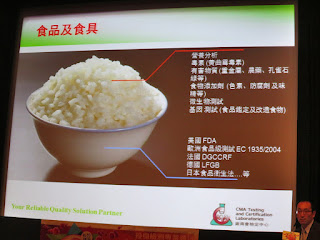Group photo of all guests and speakers
Prof. Terence Lau (Programme Director, Executive Diploma in Intellectual Property Management; Director of Innovation and Technology Development, PolyU; Adjunct Professor, PolyU) was the first speaker and his topic named "The important of R&D on Testing and Certification Industry". Firstly, Prof. Lau said we had a very good T&C infrastructure provided by HKAS and those schemes were recognized worldwide.
Prof. Lau introduced that T&C global market was huge through new regulation and outsourcing as well as globalization supply chain. The prediction growth rate was 5% per year (from 2015 to 2020) and upto USD 50.60 Billion in 2020. He said Certification was horizontal (system) and Testing was vertical (product).
Then Prof. Lau introduced different food safety problems such as Food-borne Bacteria/Virus, Bio-toxins, Malachite Green, Cadmium Rice, Meat Additive, Tainted Milk, Gutter Oil, Fake Chicken Eggs, etc. However, one of his samples about transgene Salmon was found triple size of original. He asked how we know if the salmon became a can. Then he also shared news about a plan for cloned cattle as food in China!
Prof. Lau mentioned many organic foods that needed certification label for customer to identify them. Moreover, customer sometime was not able to identify the fraud food. The following fishes were used as an example to distinguish fraud fish that the confirmation obtained through testing. Sometime it needed to employ DNA testing and he introduced the website - Barcode of Life.
Finally, Prof. Lau briefed PolyU’s knowledge transfer system to translate academic researches into real-life applications. They also formed Food Safety Consortium and their researches including Food Virus Testing, GMO Testing, Novel Biological, Chemical and Physical Testing Technologies, etc. At the end, he stated some challenges such as small local market, competition from international brands, and insufficient investment of R&D.
Mr. Y.Y. Tsang (Food Safety Specialist, Food & Pharmaceutical Division, CMATCL) was the second speaker and his presentation entitled "Food Safety: Think which you hadn’t think".
Mr. Tsang introduced the food hazard classified as three types and they were Chemical, Biological and Physical.
Then Mr. Tsang reviewed different food safety problems including artificial pigment, additive, food preservative, anti-oxidant, heavy metals, etc. He said almost 80% food toxic come from bacteria. Moreover, one of the key problems was not enough supervision on supplier.
Finally, Mr. Tsang shared McDonald’s supply criteria as follows:
- Good Reputation
- Same Value (Safety First)
- Reliable
- Management Capability of Food Quality, Safety and Risk
- Staff Competence
- Food Safety Management System
- Contract and Legal Requirement
He also shared METRO group supplier and product risk assessment at the end.
The third speaker was Mr. Joseph Chiu (Certification Manager, CMATCL) and his topic named “Product Certification Help Your Product Outstanding”. He said food safety management was like a football team. One role was Goalkeeper and the other role was Forward. Then he briefed local regulation such as Cap 132 (Public Health and Municipal Services Ordinance), Cap 362 (Trade Descriptions Ordinance) and Cap 231 (Undesirable Medical Advertisements Ordinance).
Mr. Chiu said China was the main food import to Hong Kong upto 23.9% (2015). He shared some news from mainland that local people dare to eat the food product they made! Therefore, Mr. Xi Jinping (President of the People's Republic of China) visited milk industries on 28 Jan 2014 and enforced food product safety.
Then Mr. Chiu introduced different tests in food and food container. He used rice as example to demonstrate how many test it should be done.
After that Mr. Chiu briefed how they perform the hygiene surveillance on-site and food sampling for test off-site.
Some surveillance findings were shared as following diagrams.
Finally, Mr. Chiu introduced CMA fresh label for food in which the top level named “Sashimi Grade”. Another certification was CMA-Carbon Trust which used for calculating the carbon footprint.
Q&A Session
I asked how to measure the transgene Salmon. Prof. Lau said using DNA testing could be found but the most difficult was to find the reference material. Mr. YY Tsang said Hong Kong was no legal requirement for banning Genetically Modified (GM) food but we had guideline that it should be label if more than 5% were transgene / GM. However, it was tighter in EU that label needed if more than 1%.
Reference:
CMATCL - http://www.cmatcl.com/en/index.html
Barcode of Life - http://www.barcodeoflife.org/

















沒有留言:
發佈留言